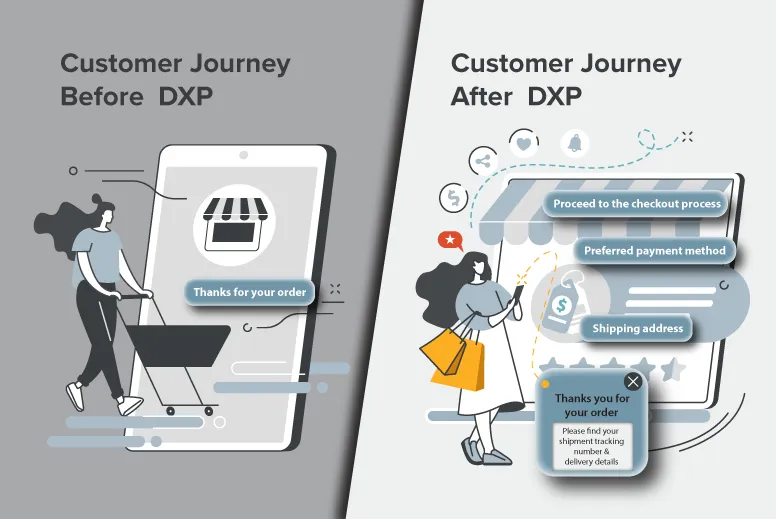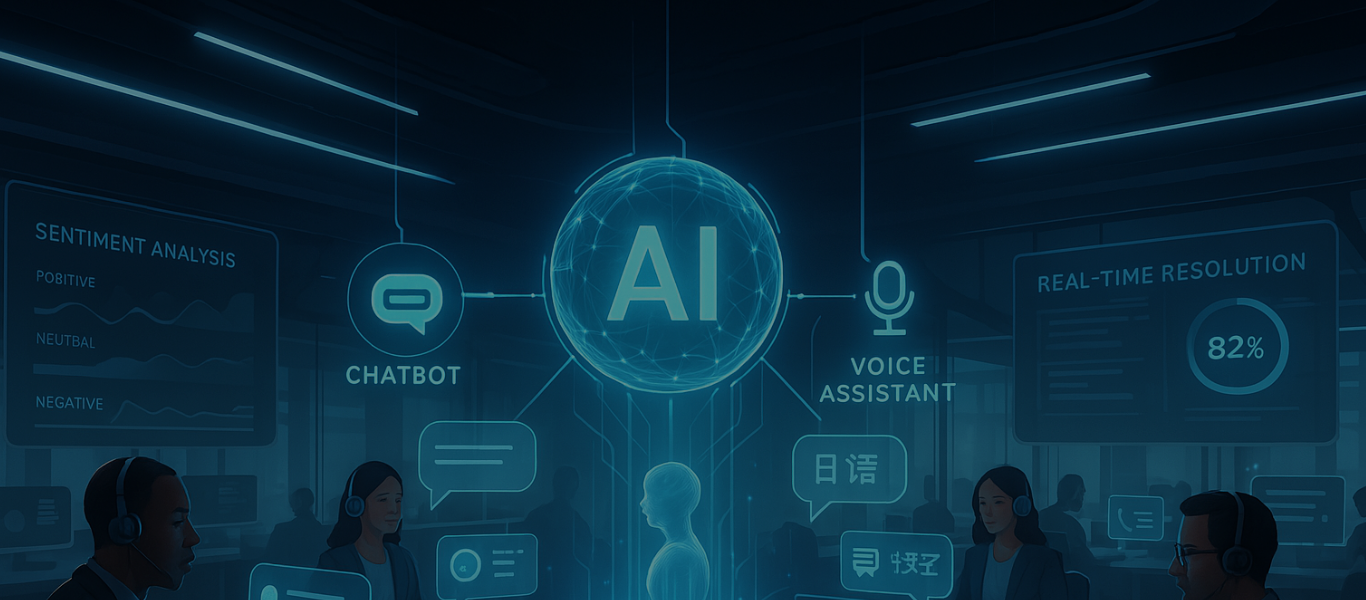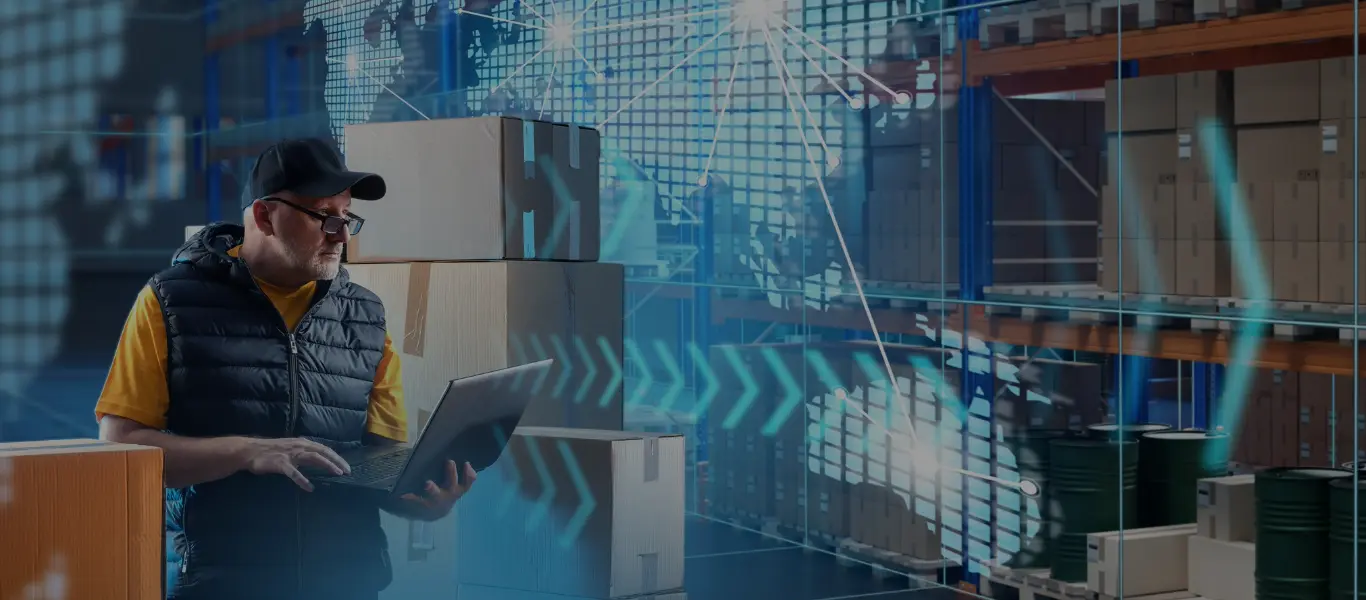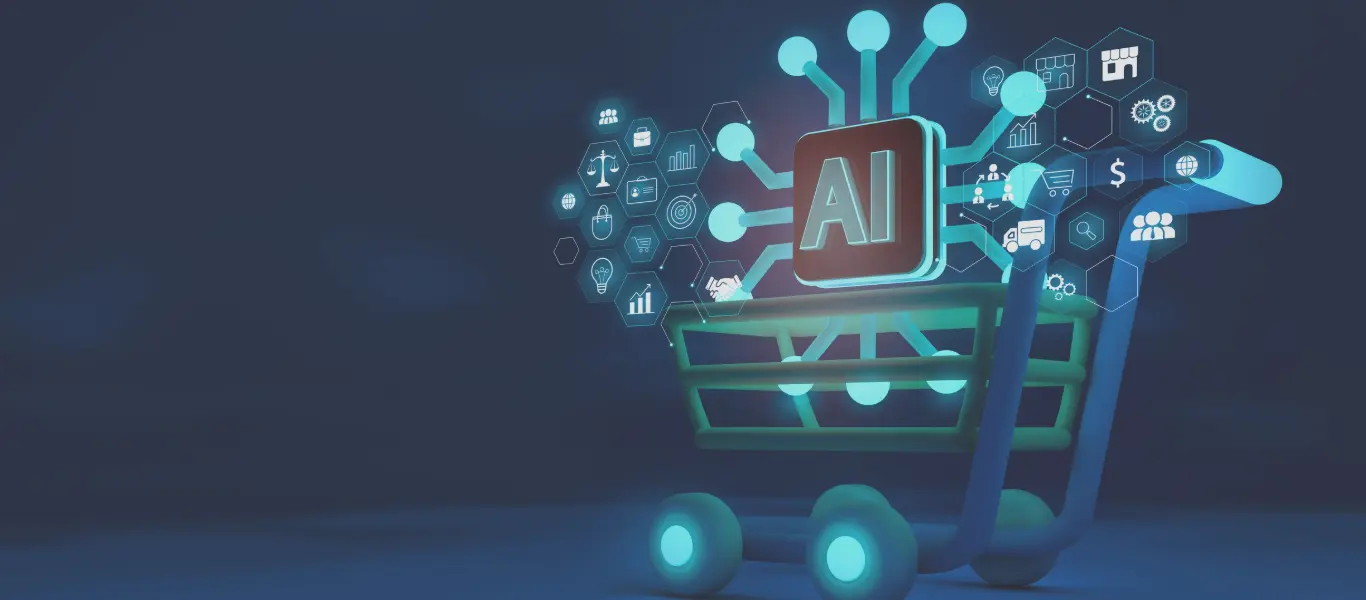What is a DXP?
Depending on whom you ask, you’re likely to get varied definitions for what exactly a digital experience platform (DXP) is. Gartner defines a DXP as “an integrated set of technologies designed to enable the composition, management, delivery and optimization of contextualized digital experiences across multiexperience customer journeys.”
In more practical terms, we define a DXP as a digital commerce platform that helps organizations create, manage, and deliver personalized digital content, offers, and experiences across all channels, including websites, mobile apps, email, social media, chatbots, customer portals, and even physical touchpoints like kiosks and IoT devices.
DXPs have taken on greater importance in recent years as buyer expectations have rapidly evolved. Brands are facing increasing pressure to meet their growing demands for more personalized experiences, as today’s digitally native buyers expect to be catered to as individual consumers. They expect offers and product suggestions to be relevant to their needs, and to be able to quickly and easily find the products they want at a competitive price, through the channels of their choice, and with convenient shipping and return options. They also expect to be able to easily access product information and customer reviews, and to receive responsive and helpful customer service both pre- and post-sale. Brands that can deliver on these expectations – and demonstrate that they truly know their customers – will be rewarded with greater market share, loyalty, and share of wallet.
DXP vs All-in-One (AIO) Commerce Platform
A DXP and an all-in-one digital commerce platform both aim to provide comprehensive solutions for businesses to manage and optimize their digital presence. However, they differ in their focus, capabilities, and use cases.
DXPs tend to focus more on providing a broad range of capabilities to manage and optimize digital experiences consistently across every digital touchpoint. They are often used in scenarios that require integration with various systems and customization to create unique, personalized experiences.
On the other hand, AIO commerce platforms focus more on providing a complete digital commerce solution that integrates a suite of tools into a single platform for managing eCommerce operations such as product and order management, payment processing, inventory management, and shipping/fulfillment.
Evolution of the DXP: Monolithic to Composable
Consider how differently business is conducted today than it was just 15 years ago for most organizations. Back then, a company’s entire digital experience strategy really only had to account for their website. DXPs were monolithic, offering an all-in-one approach consisting of prepackaged sets of non-interchangeable capabilities, typically including a content management system (CMS) and other MarTech technologies such as eCommerce applications or product information management (PIM) tools. While not easy to customize, they offered simplicity by covering all the bases in a single solution with one interface from a single vendor.

However, the explosion in the number channels that customers now use to engage with brands has given rise to composable DXPs, which are built on modular architecture that allows businesses to pursue a best-of-breed strategy by mixing and matching tools from different vendors (via API integrations) in order to create a custom digital commerce solution that meets their specific requirements.
When evaluating which type of DXP is right for your organization, there are several important factors to consider:
- Business Needs: Does your business need the ability to support a wide range of channels and devices? Do you need a DXP that can be easily integrated with your existing systems and data, is highly customizable, and enables greater agility? If so, a composable DXP will better suit your needs.
- Budget: Composable DXPs can be more expensive to implement than monolithic DXPs as you will need to acquire and integrate individual components – sometimes from multiple vendors – but they offer greater flexibility and agility. Components can be added, replaced, or removed as needed, leading to greater cost-efficiency and lower TCO in the long run. Monolithic DXPs can be more affordable upfront as you are purchasing a single integrated platform, but they can be more difficult and costly to change and customize if your business needs evolve. They also tend to acquire more technical debt over time, which is an often overlooked hidden cost in TCO. Lastly, you might also find yourself paying for functionality you don’t need or want with a monolithic DXP given its all-in-one approach. In general, composable DXPs are more cost-effective in the long run, especially for large organizations with complex needs. However, monolithic DXPs can be a good option for smaller organizations with simpler needs.
- Maintenance Costs & Updates: Composable architectures are generally associated with lower maintenance costs as compared to monolithic ones owing to their inherent nature of having loosely – rather than tightly – coupled components. Changes to one component can be made without having any cascading effects on the others. Furthermore, composable architectures are often built using cloud-based services, so individual providers handle tasks such as security, patching, and updates. And they happen at a faster pace as compared to monoliths, where suite-wide updates can take a long time to implement, and some “nice-to-have” features – or even small bug fixes – may never happen.
- Technical Expertise: Composable DXPs require more technical expertise to implement and manage than monolithic DXPs. If your organization does not have the in-house technical expertise, you may need to hire a partner to help you. However, an often overlooked benefit of composable architecture in general is that it enables business users to create, modify, and launch content without having to rely on developers for coding. So teams can post content more quickly while developers can focus on creating unique experiences and features instead of getting bogged down with marketing tasks.
- Scalability: Composable DXPs are more scalable than monolithic DXPs, so they can more easily handle increased traffic and load.
- Time-to-Market: Composable DXPs can help you get new digital experiences to market faster than monolithic DXPs because their modular, decoupled nature enables deploying new features and functionality more quickly and easily since they don’t disrupt the entire system.
- Security: Monolithic DXPs can be more susceptible to security vulnerabilities because a single vulnerability can affect the entire platform. By contrast, composable DXPs are more secure because each component can be secured individually, and response times are faster because updates and patches can be implemented outside normal development cycles.
- Vendor Lock-In: Monolithic DXPs tie you to a single vendor, making it difficult and expensive to switch to a different platform in the future. Composable DXPs offer more flexibility since you can mix and match components from different vendors, however, that also means having more vendors to manage.
Need help with your DXP strategy?
Core Capabilities of a DXP
DXPs provide a unified view of customer data that can be used to develop new products and services, as well as enable marketers to create targeted content and campaigns that are relevant to each individual customer to nurture stronger relationships and increase customer loyalty. DXPs offer a wide range of capabilities, but some of the most important include:
- Content Management: provide a central repository for all digital content, including web pages, blog posts, images, videos, and more. This makes it easy for businesses to create, manage, and deliver consistent content across all channels.
- Personalization: enable businesses to create personalized experiences for each individual customer. This can be done by using data such as purchase history, browsing behavior, and demographics to recommend products, content, and offers that are relevant to each customer. This comprehensive view of the customer journey, coupled with a DXP’s ability to automate processes and interactions based on specific triggers or customer actions, means personalization and automation can be achieved at scale and in real-time. That is a gamechanger for teams accustomed to working with traditional eCommerce and CMS platforms, where that has traditionally been a very inefficient, manual process that is very time-consuming, requires a lot of resources, and is nowhere near in real-time.
- Commerce: provide the backend functionality needed to set up an online store, including product management, payment processing, and order tracking, making it easier for businesses to sell their products and services online.
- Marketing Automation: enable businesses to automate marketing tasks such as email marketing, social media marketing, and customer relationship management (CRM). This can help businesses to save time and resources, while also improving the effectiveness of their marketing campaigns.
- Analytics: provide businesses with insights into how their customers are interacting with their digital properties. This data can be used to improve the customer experience, optimize marketing campaigns, and make better business decisions.
- A/B Testing: enable experimentation to optimize content and experiences.
How Different Types of Organizations are using DXPs Today
- eCommerce companies are using DXPs to deliver personalized shopping experiences to their customers, recommend products, and streamline the checkout process.
- Financial services companies are using DXPs to provide self-service portals for their customers, manage their accounts, and apply for loans and other products.
- Healthcare organizations are using DXPs to provide patient portals, manage appointments, and deliver telemedicine services.
- Education institutions are using DXPs to create and deliver online courses, manage student records, and provide support to students and faculty.
- Media and entertainment companies are using DXPs to deliver personalized content recommendations, manage subscriptions, and stream video and audio content.
DXPs: Your Key to Personalization
We already listed enabling personalization as one of the core capabilities of a DXP, but we would be remiss if we didn’t do a deeper dive into just how important personalization is in this day and age where the high expectations for personalized experiences only continue to grow. Buyers want to feel like they are being treated as individuals and expect brands to tailor their messages and offerings to their specific needs and interests. When customers feel like they are being seen and understood, and receive a personalized and consistent experience across all the channels they use, they are more likely to engage with a brand, make a purchase, and become repeat buyers:
- 71% of consumers expect companies to deliver personalized interactions, and 76% get frustrated when they don’t. (McKinsey & Company, 2021)
- 80% of shoppers are more likely to buy from a company that offers personalized experiences. (Epsilon, 2018)
- 60% of consumers are likely to become repeat buyers following personalized experiences. (Segment, 2023)
- 80% of consumers say they are more likely to engage with an offer if it is tailored to reflect past experiences with the brand. (Instapage, 2023)
- Companies that use advanced personalization see a return on investment of $20 for every $1 invested (Liveclicker/The Relevancy Group, 2019).
- Marketers see an average increase of 20% in sales when using personalized experiences. (Monetate, 2023)
- Personalization can reduce customer acquisition costs by up to 50%. (AdWeek, 2018)
- Companies that grow faster drive 40% more of their revenue from personalization than their slower-growing counterparts. (McKinsey & Company, 2021)
Need help with your DXP strategy?
The Customer Journey: Then and Now
The desire for greater personalization existed long before the tools and data to properly execute it were available – especially in a cost-efficient and scalable way. But notwithstanding the statistics highlighted above, and the ready availability of the necessary tools today, many companies are still offering bland customer journeys typical of 15 years ago that look something like this:
- A customer visits a website and sees a generic welcome message
- They browse the website and add a few products to their cart
- The checkout process is cumbersome and they have to enter all of their personal information, including their payment method and shipping address
- After completing their purchase, the customer receives a generic email that thanks them for their order
- The customer does not receive any follow-up emails or personalized product recommendations.

These types of generic interactions lead to lower customer satisfaction and engagement. Now let’s contrast that with what a typical customer journey can look like today when a brand leverages a DXP:
- A customer shops for shoes on a brand’s mobile app and is greeted by a personalized message that welcomes them by name and recommends products that they are likely to be interested in based on their purchase history and browsing behavior
- They add a pair of shoes to their cart, along with a pair of socks that was recommended to them
- Something comes up and they’re unable to complete their purchase
- Later, they receive a personalized reminder of their abandoned cart and visit the brand’s website on their laptop
- They find their cart still intact and proceed to the checkout process, which is quick and easy, and allows them to use their preferred payment method and shipping address
- After completing their purchase, the customer receives a personalized email that thanks them for their order and provides them with information about their shipment, including a tracking number and estimated delivery date, along with a link to the company’s customer support portal and a special incentive for joining their loyalty program
- A few days later, they receive a follow-up email asking them to review the products they purchased
- The customer also receives regular emails with personalized product recommendations and special offers.
Examining the differences between the customer journeys above, it’s not difficult to understand why personalized experiences lead to:
- Increased Customer Engagement: making content and offers more relevant and interesting to each individual customer results in increased website traffic, longer session times, and more purchases.
- Improved Customer Satisfaction: when customers feel like businesses understand their needs and interests, they feel more valued and appreciated and are more likely to be loyal and repeat customers.
- Increased Revenue: boosting customer engagement and satisfaction naturally helps businesses convert more leads into customers and increase the average order value of purchases.
In conclusion, DXPs are powerful tools that can help businesses of all sizes create personalized customer experiences, increase sales, and streamline their operations by enabling them to:
- Manage their digital content more efficiently and effectively.
- Personalize their websites, apps, and other digital properties for each individual customer.
- Sell their products and services online more easily while offering a consistent experience across all of their channels.
- Automate marketing tasks.
- Gain insights into how their customers are interacting with their digital properties.
A majority of consumers (69%) expect personal and consistent customer experiences across all of the different channels they engage with – both physical and digital – yet only about a quarter of (24%) of businesses are investing successfully in omnichannel personalization (Segment, 2021). This suggests that there is a significant opportunity for businesses to differentiate themselves from their competitors by investing in a DXP and creating personalized omnichannel customer experiences. If you are a tech buyer looking for a way to improve your customer experience, increase sales, and streamline your operations, then a DXP is a wise investment.
Are you prepared to navigate the realm of Digital Experience Platforms (DXP) and create a solution tailored to support your business needs? Connect with SkillNet Solutions today to explore how our expert guidance in DXPs can craft your path towards achieving eCommerce excellence.














